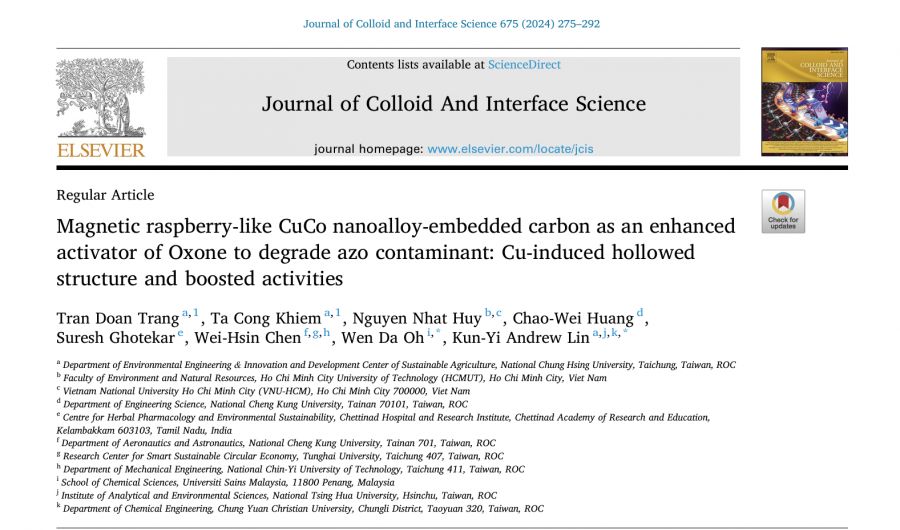循環農業:農業剩餘資材及生質衍生物高值化轉換再利用【環境工程學系/林坤儀特聘教授】
| 論文篇名 | 英文:Magnetic raspberry-like CuCo nanoalloy-embedded carbon as an enhanced activator of Oxone to degrade azo contaminant: Cu-induced hollowed structure and boosted activities 中文:磁性覆盆子狀 CuCo 奈米合金嵌入碳作為 Oxone 的增強活化劑來降解偶氮污染物:Cu 誘導的空心結構和增強的活性 |
| 期刊名稱 | Journal of Colloid and Interface Science |
| 發表年份,卷數,起迄頁數 | 2024, 675, 275-292 |
| 作者 | Trang, Tran Doan; Khiem, Ta Cong; Huy, Nguyen Nhat; Huang, Chao-Wei; Ghotekar, Suresh; Chen, Wei-Hsin; Oh, Wen Da; Lin, Kun-Yi Andrew(林坤儀)* |
| DOI | 10.1016/j.jcis.2024.06.183 |
| 中文摘要 | 偶氮化合物,特別是偶氮染料,被廣泛使用,但由於其持久性和可能形成致癌副產物而造成重大環境風險。高級氧化製程(AOP) 可有效降解這些頑固化合物,其中 Oxone 活化是一種特別有前途的方法。在這項研究中,使用 CuCo-甘油酸酯 (Gly) 作為模板,輕鬆製造了一種獨特的奈米混合材料,即覆盆子狀 CuCo 合金嵌入碳 (RCCC)。透過將 Cu 摻入 Co 中,RCCC 與不含 Cu 的 Co-Gly 衍生的類似物本質上不同,從而提供了類似爆米花的 Co 嵌入碳 (PCoC)。 RCCC 呈現出獨特的形態,具有一個空心球形層,上面覆蓋著由分佈在碳上的 CuCo 合金組成的奈米級珠子。因此,在活化 Oxone 降解有毒偶氮污染物 Azorubin S (AS) 方面,RCCC 在效率和動力學方面顯著優於 PCoC 和 Co3O4 。此外,RCCC 在高 NaCl 濃度的環境中仍然非常有效,並且可以在多個週期中有效地重複使用。此外,RCCC 也導致AS 降解的Ea比其他催化劑報告的E a值低得多。更重要的是,使用密度函數理論(DFT)計算還闡明了將Cu與Co結合作為CuCo合金在RCCC中的貢獻,而CuCo中Cu和Co的協同效應有助於增強Oxone活化,並促進SO4的產生•−和• OH。透過使用 DFT 計算研究 AS 的 Fukui 指數及其一系列降解副產物,也全面研究了 RCCC + Oxone 對 AS 的分解途徑。根據毒性評估,RCCC + Oxone 也大大降低了急性和慢性毒性,降低了潛在的環境影響。這些結果確保 RCCC 將成為 Oxone 活化降解水中 AS 的有利催化劑。 |
| 英文摘要 | Azo compounds, particularly azo dyes, are widely used but pose significant environmental risks due to their persistence and potential to form carcinogenic by-products. Advanced oxidation processes (AOPs) are effective in degrading these stubborn compounds, with Oxone activation being a particularly promising method. In this study, a unique nanohybrid material, raspberry-like CuCo alloy embedded carbon (RCCC), is facilely fabricated using CuCo-glycerate (Gly) as a template. With the incorporation of Cu into Co, RCCC is essentially different from its analogue derived from Co-Gly in the absence of Cu, affording a popcorn-like Co embedded on carbon (PCoC). RCCC exhibits a unique morphology, featuring a hollow spherical layer covered by nanoscale beads composed of CuCo alloy distributed over carbon. Therefore, RCCC significantly outperforms PCoC and Co3O4 for activating Oxone to degrade the toxic azo contaminant, Azorubin S (AS), in terms of efficiency and kinetics. Furthermore, RCCC remains highly effective in environments with high NaCl concentrations and can be efficiently reused across multiple cycles. Besides, RCCC also leads to the considerably lower Ea of AS degradation than the reported Ea values by other catalysts. More importantly, the contribution of incorporating Cu with Co as CuCo alloy in RCCC is also elucidated using the Density-Function-Theory (DFT) calculation and synergetic effect of Cu and Co in CuCo contributes to enhance Oxone activation, and boosts generation of SO4•−and •OH. The decomposition pathway of AS by RCCC + Oxone is also comprehensively investigated by studying the Fukui indices of AS and a series of its degradation by-products using the DFT calculation. In accordance to the toxicity assessment, RCCC + Oxone also considerably reduces acute and chronic toxicities to lower potential environmental impact. These results ensure that RCCC would be an advantageous catalyst for Oxone activation to degrade AS in water. |
| 發表成果與本中心研究主題相關性 | 透過本研究可進一步建立開發本研究計算所需之觸媒材料,並釐清可適合應用之環境條件! |







